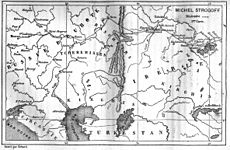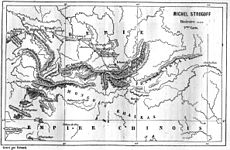 First edition, 1876 | |
| Author | Jules Verne |
|---|---|
| Original title | Michel Strogoff |
| Translator | Agnes Kinloch Kingston (published under her husband's name: W. H. G. Kingston) |
| Illustrator | Jules Férat |
| Country | France |
| Language | French |
| Series | The Extraordinary Voyages #14 |
| Genre | Adventure novel |
| Publisher | Pierre-Jules Hetzel |
Publication date | 1876 |
Published in English | 1876 |
| Media type | Print (Hardback) |
| Preceded by | The Survivors of the Chancellor |
| Followed by | Off on a Comet |
Michael Strogoff: The Courier of the Czar (French: Michel Strogoff) is a novel written by Jules Verne in 1876. Critics, including Leonard S. Davidow,[1] consider it one of Verne's best books. Davidow wrote, "Jules Verne has written no better book than this, in fact it is deservedly ranked as one of the most thrilling tales ever written." Unlike some of Verne's other novels, it is not science fiction, but a scientific phenomenon (Leidenfrost effect) is a plot device. The book was later adapted to a play, by Verne himself and Adolphe d'Ennery. Incidental music to the play was written by Alexandre Artus in 1880 and by Franz von Suppé in 1893.[2] The book has been adapted several times for films, television and cartoon series.
Plot summary[edit]
Michael Strogoff, a 30-year-old native of Omsk, is a courier for Tsar Alexander II of Russia. The Tartar Khan (prince), Feofar Khan, incites a rebellion and separates the Russian Far East from the mainland, severing telegraph lines. Rebels encircle Irkutsk, where the local governor, a brother of the Tsar, is making a last stand. Strogoff is sent to Irkutsk to warn the governor about the traitor Ivan Ogareff, a former colonel, who was once demoted and exiled and now seeks revenge against the imperial family. He intends to gain the governor's trust and then betray him to the Tartar hordes.
On his way to Irkutsk, Strogoff meets Nadia Fedor, daughter of an exiled political prisoner, Basil Fedor, who has been granted permission to join her father at his exile in Irkutsk; the English war correspondent Harry Blount of the Daily Telegraph; and Alcide Jolivet, a Frenchman reporting for his 'cousin Madeleine'. Blount and Jolivet tend to follow the same route as Michael, separating and meeting again all the way through Siberia. He is supposed to travel under a false identity, posing as the pacific merchant Nicolas Korpanoff, but he is discovered by the Tartars when he meets his mother in their home city of Omsk.
Michael, his mother and Nadia are eventually captured by the Tartar forces, along with thousands of other Russians, during the storming of a city in the Ob basin. The Tartars do not know Strogoff by sight, but Ogareff is aware of the courier's mission and when he is told that Strogoff's mother spotted her son in the crowd and called his name, but received no reply, he understands that Strogoff is among the captured and devises a scheme to force the mother to indicate him. Strogoff is indeed caught and handed over to the Tartars, and Ogareff alleges that Michael is a spy, hoping to have him put to death in some cruel way. After opening the Koran at random, Feofar decides that Michael will be blinded as punishment in the Tartar fashion, with a glowing hot blade. For several chapters the reader is led to believe that Michael was indeed blinded, but it transpires in fact that he was saved from this fate (his tears at his mother evaporated and saved his corneas) and was only pretending.
Eventually, Michael and Nadia escape, and travel to Irkutsk with a friendly peasant, Nicolas Pigassof. They are recaptured by the Tartars; Nicolas witnesses Nadia being raped by a Tartar soldier and murders Nadia's assaulter. The Tartars then abandon Nadia and Michael and carry Nicolas away, reserving him for a greater punishment. Nadia and Michael later discover him buried up to his neck in the ground. They continue onwards where they are delayed by fire and the frozen river. However, they eventually reach Irkutsk, and warn the Tsar's brother in time of Ivan Ogareff. Nadia's father, who has been appointed commander of a suicide battalion and later pardoned, joins them and Michael and Nadia are married.
Spotlight:
| Floating in Space |
凡爾納
追求進步的夢想家
Jules Verne, le rêve du progrès
【基本資料 】
‧書系:發現之旅
‧編號:XB0079
‧作者:Jean-Paul Dekiss
‧譯者:馬向陽
‧出版日期:2005/12/19
▼ 內容簡介
相信大家都看過電影《環遊世界80天》,不久前也才上映過電影明星成龍主演的老片新拍版。
原著小說則是由人稱「科幻小說之父」的法國作家凡爾納(Jules Verne,1828-1905)所創作,他另著有《海底兩萬里》、《地心之旅》、《格蘭特船長的兒女》、《神祕島》等60餘部膾炙人口的小說,作品譯本超過70種語言,改編成的電影、舞台劇與漫畫更是難以計數。
19世紀初以降,中產階級藉著金融與工業,?造出新權勢的武器,堪稱是科學大躍進的機器時代。凡爾納結合淵博的學識和廣泛的興趣,發揮絕妙的才思文筆和驚人的想像力,創作出各式各樣的「新神話」,為這段發展過程留下證據。他帶領讀者重新發現地球(地心與宇宙),重新認識各個種族和人民,預言新科學(飛行器、潛水艇等)和注重孩童的道德教育,在在都是當時發展中的共和國所推崇的價值,現今看來也深具啟發性和教育性。
今年是凡爾納辭世100週年,在其出生地南特、成名地巴黎和終老地亞眠,都盛大推出各項紀念慶祝活動。凡爾納生前曾浩歎要留下完整的作品,得活到一百歲,但預測科學發展神準的他應沒料想到自己過世一百年仍炙手可熱!現在,讓我們從閱讀本書來認識這位偉大科幻小說家吧!
▼ 作者簡介
Jean-Paul Dekiss
法國電影導演,曾拍攝25部短片與六部長片,包括《上帝不存在》(Dieu n'existe pas,1994年參加柏林影展)與《魏特曼兄弟》(Les Garcons Witman,1997年參加坎城影展)。目前是亞眠(Amien)「凡爾納之家」負責人、「作家之家暨文學遺產協會」(Federation des maisons d'ecrivains et des patrimoines litteraires)主席。著有《魔法師凡爾納》(Jules Verne l'enchanteur,Felin出版社,1999),深入探討本書中提出的各項內容。
▼ 譯者簡介
馬向陽
巴黎第八大學語言學碩士。曾任職法國在台協會、師大法語中心。譯有《消失》、本系列之《拿破崙》、《吳哥窟》、《美索不達米亞》,公共電視與前春暉影業之法語影片,並擔任口譯。目前任職台北利氏學社、華梵大學外文系,以及法國文化協會。
▼ 目錄
第一章:羅亞爾河之子
第二章:奇妙之旅
第三章:教育與娛樂
第四章:對科學抱持懷疑
見證與文獻
大事紀
電影作品輯錄
圖片目錄與出處
索引
The British Library
Jules Verne was born #onthisday in 1828. He was most famous for Voyages Extraordinaires, a series of 54 adventure novels which included science fiction classic A Journey to the Centre of the Earth. Know someone who loves this novel? #AdoptaBook for them.http://bit.ly/1AzECGq
參考翻譯






